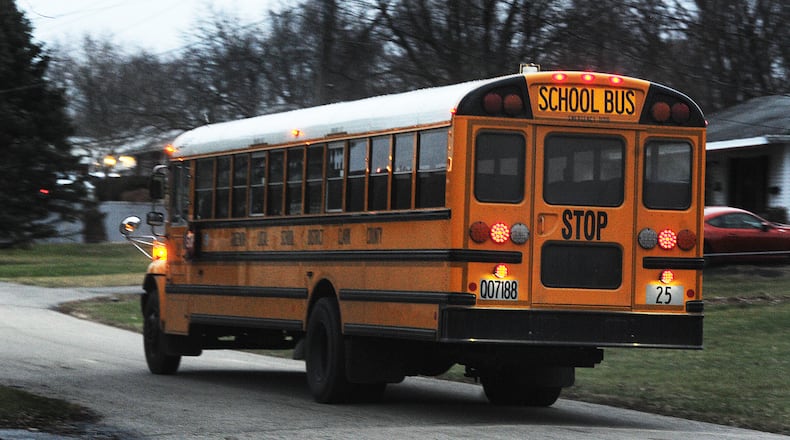“Our district is dealing with the same issues that other districts are when it comes to a shortage of bus drivers,” said John Kronour, superintendent for Northeastern Local Schools.
When there are not enough drivers, the district sometimes has to split routes or divide them up among other drivers. In some cases, even the transportation director or Kronour will run a route.
“It is not uncommon for our parents to spot Kronour picking up their students in the morning for school or dropping them off in the afternoons... He doesn’t think twice about doing what is needed to get our students to school and home safely. He also helps out with transportation for extracurricular actives,” said the district’s communications representative, Steffanie Stratton.
At Greenon Local Schools, officials are also struggling to cover routes due to long-term medical leaves and general illnesses. When the district is short on drivers, the transportation secretary or transportation director will drive routes.
“We interview quite a few applicants, and many elect to not continue with the hiring process. Reasons include no guarantee of hours, limited hours per day or week, access to benefits, no pay when school is not in session, and meeting the training requirements,” said Elmer Beard, transportation supervisor.
Although some schools have had to find other ways to cover routes, Springfield has not had to “resort to drastic measures” to cover routes or find bus drivers as the transportation office staff and supervisors are all licensed school bus drivers and have the ability to fill in for drivers if needed, said Superintendent Bob Hill.
Greenon and Clark-Shawnee local schools are also districts that either split or combine routes if there is a shortage on bus drivers, which can add 15 to 25 minutes to a student’s ride time.
When new bus drivers start, it can have an impact on districts and the time students spend on buses. Unfamiliar routes can take longer for newer employees to learn, especially when it’s pitch black in the morning or street signs have faded or are nonexistent.
At Northeastern, Kronour said it can take a new driver, or sometimes an experienced driver, longer to drive a route they are not familiar with or if students have been added to that route for the day.
While this has not had an impact on transportation at Springfield, “there is a learning curve while the employee gains familiarity,” Hill said.
At Graham Local Schools, with the district being mostly country roads, time can been added to a route if there is a missed turn because it’s not as easy as going around the block or turning around, said Superintendent Chad Lensman. To help this not happen, information is given during training and a route sheet with turn-by-turn directions for any drivers who fill in.
To help with the shortage, local districts are taking several steps such as increasing the starting wage for substitute positions, launching recruiting initiatives, training applicants to help with getting a license, having a mentor for drivers to retain them, attending job events, and having other staff on hand who already have a bus license.
Both Graham and Triad local schools have, for the most part, been fortunate enough to not have a problem with finding bus drivers.
However, Graham continues to look for substitute bus drivers, and although Triad is fully staffed, they do have a substitute and even the director of operations available to cover routes if needed.
Graham’s Director of Operations Don Burley said bus drivers are the “gateway” to a students’ day.
“I often tell them that they are the face of our school, driving big school billboards every day. We stress the importance of greeting every child in the morning and saying goodbye each evening,” he said.
“Make no mistake, the responsibility of driving a school bus with 40 to 60 students behind you while you are trying to watch the road, keep them safe, all while following directions on a schedule is overwhelming. But ask any of our bus drivers; it is a rewarding career where you can care for and support students as they grow. There is nothing more rewarding than that.”
Springfield employs 30 regular drivers, two substitutes and three driver trainees; Northeastern has 24 drivers; Clark-Shawnee has 19 regular drivers and four substitute drivers; Greenon has 19 regular drivers and six substitute drivers; Graham has 14 regular drivers, one floating substitute and one as-need substitute; Triad has nine regular bus drivers and one substitute.
What can help?
Interim state superintendent Stephanie Siddens met with charter and public school leaders last month to discuss the ongoing issues with busing. Public school administrators said they need more help from the state in training and attracting more bus drivers.
Ohio has one of the strictest standards for bus drivers in the country, and school leaders said they don’t want to change the high standard. But many said state money to assist districts that train drivers would be helpful, or even using the National Guard to help drive buses on a temporary basis.
“Funding school transportation at a higher level so we can be competitive with private transportation companies that require a CDL would be a first step,” Wood said.
By the numbers:
13, dollars per hour, starting wage for some substitute drivers
23, dollars per hour, starting wage for some substitutes
30, regular bus drivers, two substitutes employed by Springfield schools
About the Author

